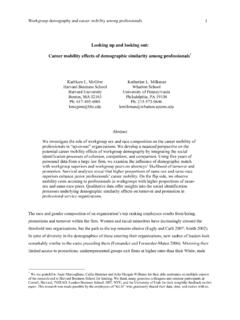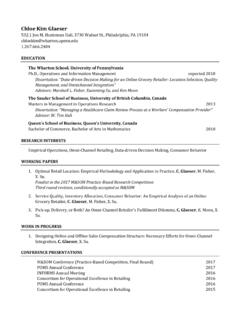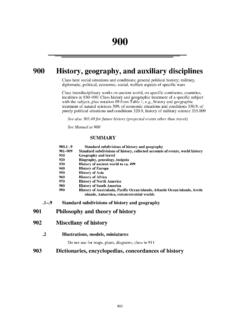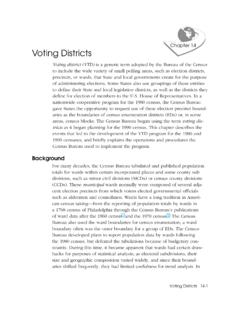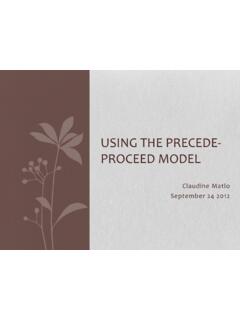Transcription of Market segmentation - Wharton Faculty Platform
1 CHAPTER 11 Market segmentationYORAM (JERRY) WIND and DAVID R. BELLAll markets are heterogeneous. This is evident fromobservation and from the proliferation of popularbooks describing the heterogeneity of local andglobal markets. Consider, for example, The NineNations of North America(Garreau, 1982), Latitudesand Attitudes: An Atlas of American Tastes, Trends,Politics and Passions(Weiss, 1994) and MasteringGlobal Markets: Strategies for Today s Trade Globalist(Czinkota et al., 2003). When reflecting on the natureof markets, consumer behaviour and competitiveactivities, it is obvious that no product or serviceappeals to all consumers and even those who pur-chase the same product may do so for diverse rea-sons.
2 The Coca Cola Company, for example, varieslevels of sweetness, effervescence and package sizeaccording to local tastes and conditions. Effectivemarketing and business strategy therefore requiresa segmentation of the Market into homogeneoussegments, an understanding of the needs and wantsof these segments, the design of products and serv-ices that meet those needs and development of marketing strategies, to effectively reach the targetsegments. Thus focusing on segments is at the core of organizations efforts to become customerdriven; it is also the key to effective resource alloca-tion and deployment. The level of segment aggre-gation is an increasingly important issue.
3 In today sglobal economy, the ability to customize productsand services often calls for the most micro of seg-ments: the segment of one. Following and imple-menting a Market segmentation strategy allows thefirm to increase its profitability, as suggested by theclassic price discrimination model which providesthe theoretical rationale for the early 1960s, segmentation has beenviewed as a key marketing concept and has beenthe focus of a significant part of the marketingresearch literature. The basic concept of segmenta-tion (as articulated, in Frank et al., 1972) hasnot been greatly altered. And many of the funda-mental approaches to segmentation research arestill valid today, albeit implemented with greatervolumes of data and some increased sophistica-tion in the modelling method.
4 To see this, considerthe most compelling and widely used approach toproduct design and Market segmentation con-joint analysis. The essence of the approach out-lined in Wind (1978) is still evident in recent workby Toubia et al. (2007) that uses sophisticated geo-metric arguments and algorithms to improve theefficiency of the method. Other advances use for-mal economic theory to specify optimal consumertrade-offs see Iyengar et al. (2007) for an applica-tion to non-linear the underlying stability of the basicconcept, recent advances in information technologyand the trend towards globalization are introducinga discontinuous change to the adoption and imple-mentation of segmentation strategies.
5 The revolu-tion in information technology and strategy makespossible the creation of databases on the entire uni-verse and enormous advances in database Market -ing and innovative distribution approaches. It hasalso facilitated much of the development in flexiblemanufacturing with the consequent emergence ofmass customization. In addition, the Internet hasexpanded not only the ability to implement marketsegmentation research more effectively, but alsoexpanded the portfolio of segmentation methodsavailable for use (see, Dahan and Srinivasan,2000). These changes are leading to the creation of one-on-one marketing or segments of one. 8/8/07 2:04 PM Page 222 Market segmentation223globalization of business expands the scope ofoperations and requires a new approach to local,regional and global segments.
6 Moreover, busi-nesses that have not traditionally embraced mar-keting in general or segmentation in particular, seeit as imperative for success and even the current enormous effort by the lead-ing financial services firms to understand how tosegment the global at-retirement Market fuelled bythe baby boomers in North America and WesternEurope. Finally, it is important to recognize a subtlebut pervasive shift in the basesfor , marketers segment the Market accord-ing to characteristics ( demographics), prefer-ences, usage rates, etc. Increasingly, it is difficult tofully articulate a segmentation strategy without anaccompanying discussion of customer lifetimevalue (CLV) and a thought process that makes theCLV calculation explicit (see Gupta and Lehmann,2003).
7 These changes require not only an appraisalof what we know about segmentation , and whatworks and does not work, but also a review of thesegmentation area as part of an entirely new mar-keting and management , the purpose of this chapter is tointroduce the reader to both the best practice inthe segmentation area and the likely new develop-ments. These observations are based on advancesin marketing concepts, marketing science researchand modelling tools, generalizations from empir-ical studies, successful practices of leading firmsand the conceptual implications of operating inthe global information age. This discussion of thebest segmentation practices and likely advancesencompasses five areas:1 Use of segmentation in marketing and Decisions required for the implementation of asegmentation Advances in segmentation Impact of operating in the global information ageon segmentation theory , practice and Expansion of segmentation to other , this chapter is based on the premise thatsegmentation is the firm s response to a funda-mental Market feature heterogeneity.
8 The likelysuccess (or otherwise) of the firm s segmentationstrategy is assessed through a segmentation auditdiscussed next. The firm enacts the segmentationstrategy through: (1) data collection, (2) applica-tion of models and frameworks and (3) resourceallocation and differential action based on seg-ment (customer) value. The chapter concludeswith a set of critical issues that provide the guide-lines for research agenda in this of segmentation in marketingand business strategyConceptually any business strategy should bebased on understanding, meeting and evenexceeding the needs of target segments. Figure the centrality of segmentation and theprogression of fundamental questions to the core is the identification of the existing andpotential customer base, an understanding ofunderlying heterogeneity and the evolving needsand wants of target segments.
9 Next is the responseto segmentation , namely guidelines for the devel-opment of products and services, and their associ-ated positioning to meet the evolving needs of thetarget segments. Finally, the product positioningprovides the foundation for the rest of the Market -ing strategy and the processes, resource allocationdecisions and other activities of the published and unpublished casestudies attest to the value of segmentation . Forexample, Bell et al. (1998) show how segmentationof store choice decisions of supermarket shoppersreveals fundamental differences in store attractive-ness, conditional on a shoppers preferred shoppingstyle. The model illustrates how one store formatcan capture Market share from another.
10 It is import-ant to recognize that applications of segmentationcover a diversity of business contexts. In an indus-trial buying setting, Gensch et al.(1990) providecompelling evidence of the positive consequencesof segmentation of electrical equipment buyers. Ina 1-year test segmentation applied in two of threegeographic districts, sales increased 18 and 12 percent while sales declined 10 per cent in the districtin which model-based segmentation was notapplied and 15 per cent for the industry. The firmreports continuous Market share increases from theapplication of the segmentation approach. This isnot an isolated case. The popular business pressand the conference circuit are full of anecdotal casesin which creative segmentation has paid off.


